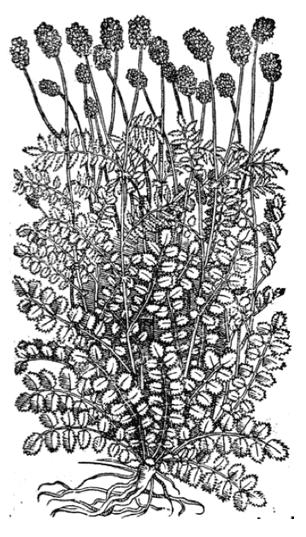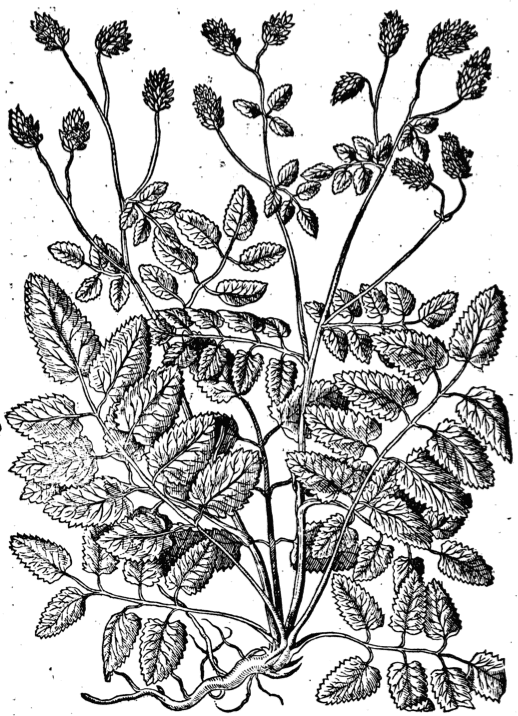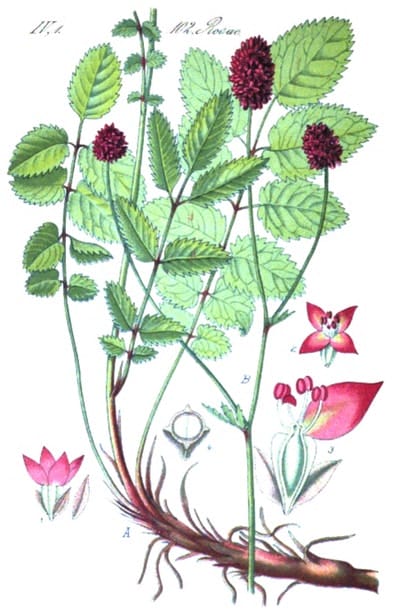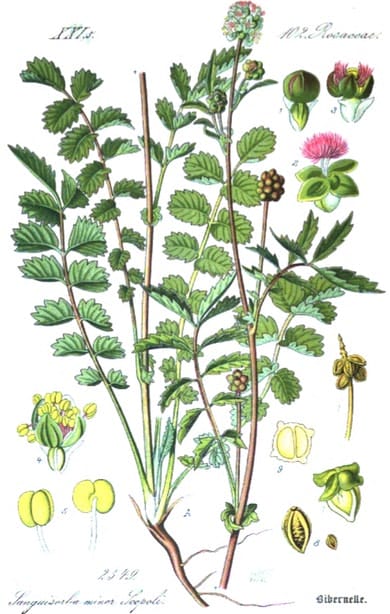Sanguisorba, Burnet, Di Yu 地榆
Di Yu (TCM)

|

|
|
Della Materia Medicinale, Andrea Valuassori, 1562 |
New Kreuterbuch, Matthiolus, 1563 |
 S. officinalis
S. officinalisFlora von Deutschland (25), Kohler, 1886 |
 S. minor
S. minorFlora von Deutschland (25), Kohler, 1886 |
Botanical name:
Sanguisorba officinalis
Greater and Lesser types were known
Parts used:
Root
Temperature & Taste:
Slightly Cool, dry. Bitter, Sour. ‘of a pleasant nature’.
Classifications:
2P. HEMOSTATIC
3C. ALEXIPHARMIC
TCM:
L. Stop Bleeding
Uses:
1. Cools the Blood, Stops Bleeding: (TCM, West)
-all types of Bleeding associated with Heat, especially of the lower body.
–‘is also most effectual to stop the monthly courses’ (Gerard)
–‘stay fluxes and bleedings, for which purposes it is much commended in Contagious and Pestilential Agues’.
-useful for Ante- and Postpartum disorders (Da Ming)
-the carbonised root (stir-fried until scorched) is used in TCM to stop bleeding
2. Stops Leakages (TCM, West):
-Leukorrhea, Spermatorrhea, Diarrhea
-Prevents Miscarriage. (Salmon)
-‘stops Perspiration’ (Shen Nong Ben Cao)
3. Clears Heat, Resists Poison (TCM, West):
-‘Great force for Plague, Pestilence and all malign diseases … it is good in a Diet against the French Pox’. (Salmon)
-Dysentery with blood (TCM, West)
-preserves from infection.
-Tumors, Cancer
-‘neutralizes toxins due to alcoholism’ (Ming Yi Bie Lu)
4. Moves the Qi, Calms the Heart and Mind:
-‘quickens the Spirits, Refresh and Cheer the Heart, and Drive away Melancholy’ (Culpeper)
–‘The leaves of Burnet steeped in wine and drunken, comfort the Heart, and make it merry, and are good against the Trembling and shaking thereof’ (Gerard)
5. Clears Heat and Phlegm, Stops Cough:
-Catarrh, Coughs and Asthma.
-Tuberculosis
6. Tonic:
-‘Continual use preserves the body in health and the Spirits [Qi] in vigor … It is a friend to the Heart, Liver, and other principal parts of a Man’s body’ (Culpeper; Candied Root is a stronger tonic)
7. Externally:
-Sores, Wounds and Burns. It dries excess fluid and promotes the generation of new flesh.
-Old Ulcers, Fistulas, Cancer (Matthiolus)
-‘malignant and hot sores’. (Ming Yi Bie Lu)
-powdered seed can also be applied to moist sores.
-applied to Snake and Insect Bites.
-externally for skin conditions including Eczema

Dose:
1. The leaf can be used similarly to the Root, but is weaker.
2. Juice of the whole herb was used against Poison.
3. The candied root is a stronger tonic.
4. The carbonised root is a stronger hemostatic.
5. The head of the root was regarded as a stronger hemostatic, especially when stir-fried. The tail of the root was regarded as better to move the Blood. (Li Shi Zhen)
Decoction: 5–15 grams, and from 30–60 grams in severe cases, or when the herb is used alone
Powder: 1–3 grams
Freshly Expressed Juice: 5–20 mls., 2–3 times daily;
Tincture (1:5 in 45% alcohol): 30–50 drops.
Preparation:
1. Stir-fried Burnet root:
It is stir-fried to brown or burnt to charcoal to strengthen its hemostatic and astringent effects. Research has shown it is best done by stir-frying it in a frying pan for 7 and a half minutes at 250 degrees C. This increases amounts of trace elements (on a weight-for-weight basis), as well as significantly increasing the hemostatic and bacteriostatic effects. (TCM)
2. Candied Burnet root:
Burnet root was Candied as other roots were, to make it more tonifying. (West)
Substitute:
Culpeper said ‘Little inferior to Betony’.
Main Combinations:
1. Diarrhea and Dysentery, Burnet with Tormentil (equal parts) (Fischer)
2. Diarrhea or Dysentery with Blood in the stool:
i. Burnet with Scutellaria Huang Qin
ii. Burnet with Ailanthus Chun Pi
iii. Burnet with Horsetail (TCM)
iv. Burnet with Agrimony
v. Burnet, Sophora fruit Huai Jiao, Scutellaria Huang Qin
vi. Burnet, Madder, Coptis Huang Lian
3. Bleeding Intestinal Abscess, Burnet, Lonicera Jin Yin Hua, Scutellaria Huang Qin (TCM)
4. Excessive Menstruation, Uterine Bleeding:
i. Burnet, Madder
ii. Burnet with Ladies Mantle and Shepherd’s Purse (Müller)
iii. Burnet, Astragalus Huang Qi, Dang Gui, Dipsacus Xu Duan, Artemisia Ai Ye
iv. continuous, Burnet, Alum, Galls (TCM)
5. Coughing Blood, Burnet, Pyrrosia Shi Wei
6. Nervous Heart disorders, combined Burnet with Rue, Borage and Balm
7. Madness, Burnet with Willow leaf, Meadowsweet, Borage, Balm, St Johns wort, Camphor (The London Practice of Physic, Dr. Willis, 1689)
8. Cancer:
i. Burnet has been combined with Black Nightshade in China
ii. Burnet has also been combined with Bittersweet and Agrimony in China.
9. To preserve from Plague and Epidemic diseases, Burnet, Rosemary, Wormwood, Balm, Blessed Thistle, Betony, Angelica, Zedoary, Licorice, Elecampane, Sage, Calendula
10. Topically to burns:
i. prepare a powder of Burnet and Ampelopsis Bai Lian and apply.
ii. make a paste of Burnet, Rehmannia Sheng Di Huang and Sesame oil and apply
Major Formulas:
Decoction for the Womb (Schroder)
Decoction of Parsley Compound
Syrup of Marshmallow (Fernel)
Syrup of Comfrey Compound
Electuary of Seeds
Cautions:
1. Not suitable for use in Cold bodies
2. ‘In a case of dysentery complicated with general debility and cold or dysentery with watery and white discharge, it should not be used’. (Kou Zong Shi)
Main Preparations used:
Distilled Water of the whole Plant, Syrup of the Juice, Conserve of the Flowers
